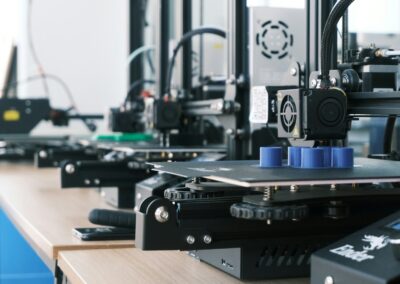Harnessing the Power of Realistic Simulations and Virtual Environments
The Rise of Digital Twins in Education and Training
The potential for Digital Twins in Education and Training to revolutionize learning methodologies is immense. Digital twins, virtual replicas of physical systems or environments, provide an innovative approach to education and professional training. By creating realistic simulations and immersive virtual environments, these technologies enhance the learning experience, making it more interactive and effective. In regions like Saudi Arabia and the UAE, where technological advancements are rapidly embraced, the adoption of digital twins in education is set to transform traditional pedagogies.
Digital twins allow for the creation of detailed, dynamic models that can replicate real-world scenarios. This capability is particularly valuable in fields requiring hands-on experience, such as engineering, medicine, and architecture. Students can engage with complex systems in a controlled, risk-free environment, allowing them to experiment and learn from mistakes without real-world consequences. For instance, medical students can practice surgeries in a virtual operating room, engineers can simulate the construction of buildings, and architects can explore different design concepts in a virtual space.
The integration of digital twins into educational institutions in Riyadh and Dubai is already showing promising results. By leveraging this technology, these institutions can provide a more comprehensive and engaging learning experience. The realistic simulations offered by digital twins enable students to gain practical skills and knowledge that are directly applicable to their future careers. This hands-on approach to learning not only enhances understanding but also boosts confidence and preparedness among students.
Enhancing Professional Training with Virtual Environments
In addition to transforming education, Digital Twins in Education and Training are also revolutionizing professional training. Industries such as healthcare, aviation, and manufacturing are increasingly utilizing digital twins to create realistic training environments. These virtual environments allow employees to acquire and refine skills in a safe, controlled setting, leading to higher proficiency and reduced risk of errors in real-world applications.
For example, in the healthcare sector, digital twins can simulate patient care scenarios, enabling medical professionals to practice and perfect their responses to various medical conditions. This type of training is invaluable for improving patient outcomes and ensuring that healthcare providers are well-prepared for any situation. Similarly, in the aviation industry, pilots can train on virtual replicas of aircraft, allowing them to experience and respond to different flight conditions and emergencies without the need for physical flight hours.
The adoption of digital twins for professional training is particularly relevant in regions like the UAE and Saudi Arabia, where there is a strong emphasis on advancing technological capabilities. By incorporating digital twins into their training programs, businesses and organizations can ensure that their workforce is highly skilled and capable of meeting the demands of modern industries. This not only enhances operational efficiency but also positions these regions as leaders in technological innovation and professional excellence.
Strategic Advantages for Business Success
The implementation of Digital Twins in Education and Training offers significant strategic advantages for business success. By providing employees with advanced training tools and realistic simulations, companies can enhance their workforce’s skills and productivity. This leads to improved performance, reduced downtime, and increased competitiveness in the market. Additionally, the ability to simulate and analyze different scenarios allows businesses to make informed decisions, optimizing processes and minimizing risks.
Incorporating digital twins into leadership and management training programs also presents numerous benefits. Executives and managers can engage in virtual simulations that replicate complex business scenarios, allowing them to develop and refine their decision-making skills. This experiential learning approach helps leaders to better understand the implications of their choices, fostering more strategic and effective management practices.
For entrepreneurs and mid-level managers, the use of digital twins can provide valuable insights into market trends, customer behavior, and operational efficiencies. By leveraging this technology, they can test new strategies and innovations in a virtual environment before implementing them in the real world. This reduces the risk of failure and enhances the likelihood of success, ultimately driving business growth and profitability.
Conclusion: Embracing Digital Twins for Future-Ready Education and Training
In conclusion, the potential of Digital Twins in Education and Training to enhance learning and professional development is transformative. By creating realistic simulations and immersive virtual environments, digital twins offer a powerful tool for improving educational outcomes and workforce proficiency. In regions like Saudi Arabia and the UAE, where technological innovation is a key focus, the adoption of digital twins is set to revolutionize traditional approaches to education and training.
As we move towards a future increasingly shaped by advanced technologies, embracing digital twins will be crucial for staying competitive and achieving business success. By integrating these technologies into educational institutions and professional training programs, we can ensure that students and employees are well-equipped to meet the challenges of the modern world. This forward-thinking approach not only enhances individual capabilities but also drives collective progress and innovation.
The strategic implementation of digital twins in education and training will undoubtedly pave the way for smarter, more efficient learning and development practices. By leveraging the power of realistic simulations and virtual environments, we can create a future where knowledge and skills are continually enhanced, leading to a more skilled, adaptable, and successful workforce.
—
#DigitalTwins #Education #Training #VirtualEnvironments #RealisticSimulations #SaudiArabiaInnovations #UAETechnologicalAdvances #RiyadhEducationalTechnology #DubaiTrainingSolutions #ModernTechnology #BusinessSuccess #LeadershipSkills #ManagementSkills #ProjectManagement #GenerativeAI #BlockchainInEducation























